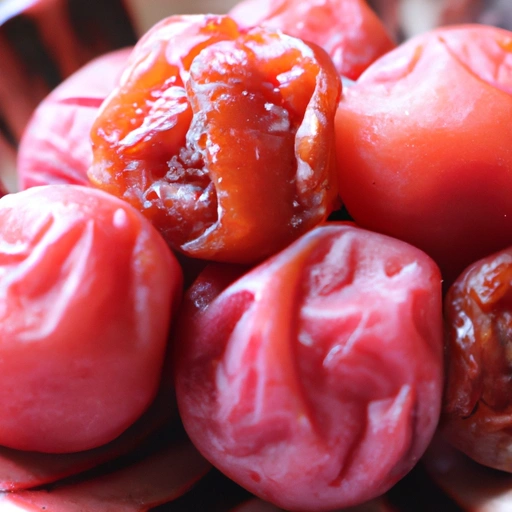Umeboshi
Description

Umeboshi, a staple of Japanese cuisine, is a pickled plum with a distinctly tart and salty flavor. These small, wrinkled fruits are often a shade of pink or red and are typically made from ume, a type of Japanese apricot that is closely related to the plum family. Umeboshi is made by preserving ume fruits in salt and then drying them under the sun. Often, shiso leaves are added during the pickling process, giving umeboshi their characteristic pink hue and additional flavor complexity.
Common uses
Umeboshi is commonly used as a condiment or a palate cleanser in Japanese cuisine. It's often served with rice, either placed on top of a bowl of rice or inside onigiri (rice balls). Additionally, umeboshi is used to flavor sauces, dressings, and as a pickled component in bento boxes. Its unique flavor also makes it a popular addition to beverages, like umeboshi vinegar drinks, and as a garnish for various dishes.
Nutritional value
Calories
Umeboshi contains approximately 33 calories per 100 grams (about 3.5 oz).
Protein
There is about 1 gram of protein per 100 grams of umeboshi.
Fat
Umeboshi is virtually fat-free, with less than 0.2 grams of fat per 100 grams.
Carbohydrates
Carbohydrates in umeboshi amount to about 11 grams per 100 grams, primarily from sugars.
Vitamins
Umeboshi is a source of vitamin C and provides small amounts of vitamins A and B complex.
Minerals
Rich in minerals, umeboshi contains potassium, magnesium, and calcium. It also has a high sodium content due to the pickling process.
Health benefits
Umeboshi is thought to aid in digestion and help maintain a healthy pH balance in the body. The presence of citric acid can help combat fatigue, while the fruit's natural antibacterial properties may support immune health. Additionally, umeboshi's antioxidants are believed to help neutralize free radicals.
Potential risks
Due to its high salt content, umeboshi should be consumed in moderation, especially by those with hypertension or on a low-sodium diet. Overconsumption can lead to an imbalance of electrolytes and other health issues related to excessive sodium intake.
Common recipes
Umeboshi is traditionally used in Japanese recipes such as onigiri, sushi, and as a component in tsukemono (pickled vegetables). It's also mashed into pastes for spreads or dips.
Cooking methods
While typically consumed in its pickled form, umeboshi can also be used in cooking to add a sour and salty flavor to dishes such as stir-fries, dressings, and marinades.
Pairing with other ingredients
Umeboshi pairs well with rice, vegetables, and mild proteins like tofu or chicken. Its acidity can also balance out the richness of fatty fish like mackerel.
Summary
Umeboshi is a uniquely flavorful ingredient with a rich cultural history and a variety of health benefits. Its culinary versatility makes it a prized component in both traditional and contemporary recipes, adding a distinct tangy and salty taste to an array of dishes. While it should be consumed in moderation due to its sodium content, umeboshi's nutritional profile and potential health benefits make it a valuable addition to a balanced diet.